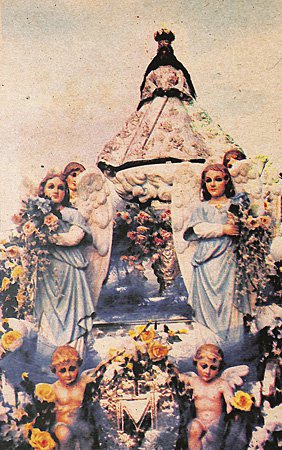Cultural Center of the Philippines
ENCYCLOPEDIA OF
PHILIPPINE ART
Our Lady of Peace and Good Voyage / Nuestra Señora de la Paz y Buen Viaje
Also known as Birhen ng Antipolo (Virgin of Antipolo) / Early 17th century / Wood / Approximately 120 centimetres in height / Antipolo City, Rizal Province
Our Lady of Antipolo is popular for being a dark-skinned image. The heads and hands are made of dark hardwood and polished with oil, causing the further darkening of the wood over the years. This gave the image a golden brown complexion Filipinos have identified with. In 1639, Chinese residents of Antipolo rioted and tried to burn and strike the image with their weapons. The image sustained wound-like cuts on its right cheek and neck, which are still visible today (Mercado 1980, 49). The image is a de bastidor type—meaning, the heads and hands are attached to a mannequin frame, on to which the blouse, skirt, and cape of richly embellished luxurious fabrics are draped (Jose 1991, 121, 192). The image of the Virgin of Antipolo stands regally with hands poised below her bosom holding a field marshall’s baton in memory of the cane that Governor-General Arrechedera offered her after her last voyage in 1746 (Mercado 1980, 84). The image wears an imperial crown, a diadem, and an aureole of 12 stars. From the gifts of devotees, the image accumulated over the centuries a notable treasury of jewels, many of which no longer exist. On both hands she wears large gems, giving the impression that the image has a diamond ring on each finger. To this day, the image stands on a pedestal created from the tipolo tree, which is reputedly the same tree where the Jesuits found her whenever the image disappeared at night from the mission village.
This statue of the Virgin Mary was brought by Governor-General Juan Niño de Tabora to the Philippines in 1626 from a parish in Acapulco. The image was bestowed with the title “Paz y Buenviaje” (Peace and Good Voyage) by a public decree dated 8 September 1653 under Governor-General Sabiniano Manrique (Mercado 1980, 45, 77). This title is historically intertwined with the Manila-Acapulco galleon trade. Faced with the perils of spending many months at sea, the travelers on the galleons implored the heavens to give each galleon a safe voyage. It was the custom then to enshrine an image of a saint on every galleon that was to sail. Among all those that boarded the galleons, only the image of Our Lady of Peace and Good Voyage has a record of eight successful voyages: six successful round trips and two aborted midway although these ships were able to return safely. In addition, attributed to this image was one victorious naval war against the Dutch at the port of Cavite in June 1647. It was remarked that every time the image was on board, peace and harmony reigned within the ship. Elaborate thanksgiving celebrations were done in the Lady’s honor each time the galleon docked safely on Philippine shores. The fluvial procession in her honor was held several times, including on the occasion of her canonical coronation in 1926 (Mercado 1980, 16-17) when she was taken on a procession from Antipolo down to Rizal Park. The tradition of the Virgin’s fluvial procession on the Pasig River was detailed in Jose Rizal’s zarzuela, Junto al Pasig (Beside the Pasig).
The parish shrine of the Virgin of Antipolo celebrates its annual feast on the eighth of December, the date dedicated to the Immaculate Conception. However, more popularly attended is the annual Antipolo pilgrimage season, which peaks in the month of May (Roces 1980, 89; Mercado 1980, 56). The Virgin of Antipolo and the devotion to her title has been the subject of significant Filipino art, music, film, and literature. As she is the symbol of peace and good voyage, the tradition of imploring her blessing for a safe trip continues to live and evolve even as other forms of travel developed through time.
Written by Dino Carlo S. Santos (2018)
Sources
Jose, Regalado Trota. 1991. Simbahan: Church Art in Colonial Philippines 1565-1898. Makati City: Ayala Museum.
Mercado, Monina A. 1980. Antipolo: A Shrine to Our Lady. Makati: Craftnotes for Aletheia Foundation.
Roces, Alejandro R. 1980a. “Antipolo Pilgrimage.” In Fiesta, 89-103. Quezon City: Vera Reyes.
